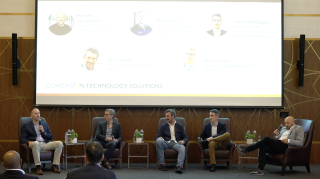The Evolution of Tune-In Campaigns
May 31, 2017

It was a lot easier to get viewers excited about “tuning in” to a new program when the living room was the only place to watch it. Back then, the lack of choice made it a lot easier for consumers, too; but we don’t just decide “what” to watch anymore. We also decide how and when we’re going to watch it. Any new program has to fight an uphill battle to reach new viewers across a sea of devices and competition. Exceptional content can certainly do its part to sell itself, but optimizing its value in the marketplace takes a scientific approach.
The Upfronts season recently concluded for broadcasters, a time where they showcased programming plans for the year in order to generate interest and entice media buyers to purchase advertising space “up front” in addition to the buying that will occur throughout the year (referred to as “scatter” ad spend). In 2011, The Interactive Advertising Bureau started its own similar event called NewFronts, to provide a similar “futures market” arena for digital programming. NewFronts isn’t representative of the entire digital content universe – some providers are combining broadcast and digital upfronts in their own presentations. Still, it does drive home the fact that regardless of how diverse our TV habits have become, advertising remains as a growing economic engine for the industry.
A great show needs lots of mindshare in order for a media buyer to consider it a hot property for other advertising. But how can a simple “watch my show” commercial rise above the clamor from hundreds of channels? To execute a complete and compelling tune-in campaign, advertisers keep their focus on the audience in order to find the best way to connect a piece of content to the right viewer. This means:
1.Finding new ways to engage the right audience:
When viewers keep the online conversation alive, a new season or episode can transcend the individual tune-in experience and becomes more of a community event. By using social media ads to increase the engagement and participation of an existing fanbase, advertisers can put fans to work for the cause – generating more buzz and online dialogue. Creating ways to turn viewers into ad distributors (i.e. posting a trailer to Facebook) is a winning formula to bring in new eyes and coax lapsed viewers to tune back in.
2.Meeting each viewer on his/her own terms – and device:
These days, a good show can really get around. It might be shown on broadcast television, through a content aggregator (like Netflix or Hulu), and through a direct-to-consumer app. Each destination needs an ad version that’s tailored for the environment it’s being delivered in, whether it’s mobile, social, or through any over-the-top (OTT) device connected to the television. And, when a program moves from live linear programming to video-on-demand asset, the details of an ad’s message need to change too.
The Ever-Changing Call to Action
It’s that last bit – monetizing a media asset throughout its lifecycle – that makes managing a tune-in ad campaign feel a lot like herding cats. A top-tier program might start its ad campaign months before its premiere. A countdown approach would require a change to every ad spot on every platform as the message changes from “May 2018” to “In Three Weeks” to “Tomorrow” to “On Demand.” The sheer volume of asset versioning and tagging for one program can be astronomical. And, now that every piece of content exists in perpetuity, there’s a whole new layer of tune-in advertising to bring viewers back to old content that might be getting a new lease on life. If Beverly Hills, 90120 gets a third remake, you can bet that the original series is going to get a monetization make-over.
The TV lovers among us know that as content consumers, we’ve got more control over the future of our programming than we ever have before. The advertisers among us know that if they want to win the hearts and minds of a video-driven world, they’re going to have to do it one screen at a time. Fortunately for them, new delivery mechanisms are allowing them to concentrate on what matters most – creating a compelling message that can be heard above all the noise.
Interested in learning more about tune-in or other high-intensity campaign delivery? Contact us




